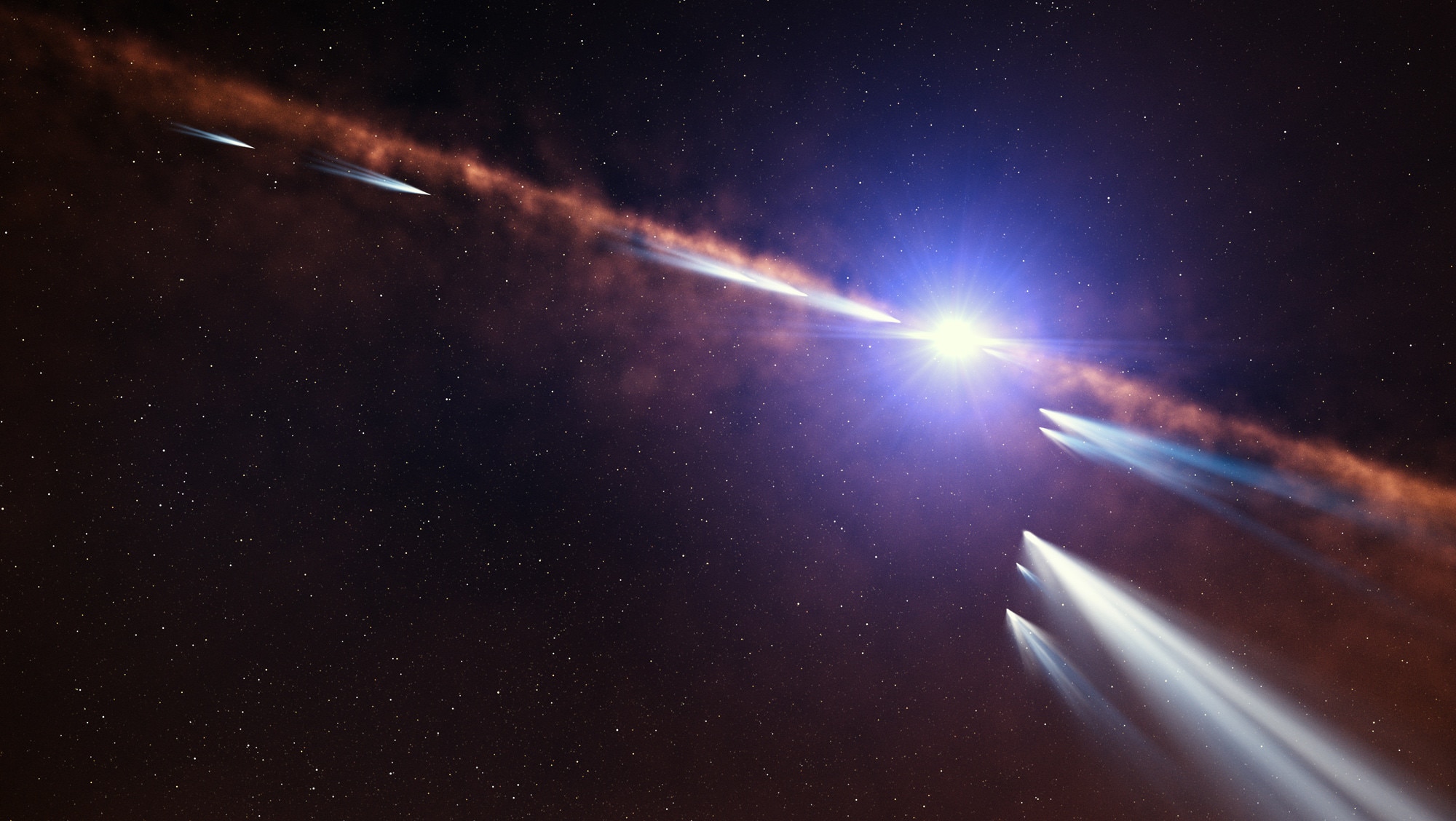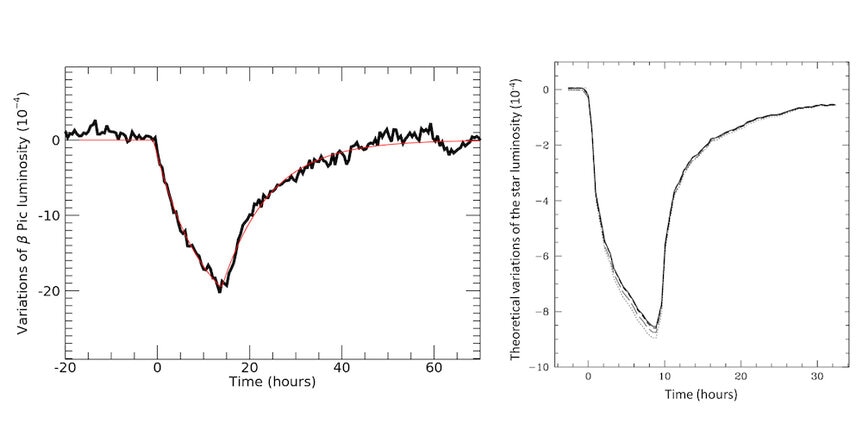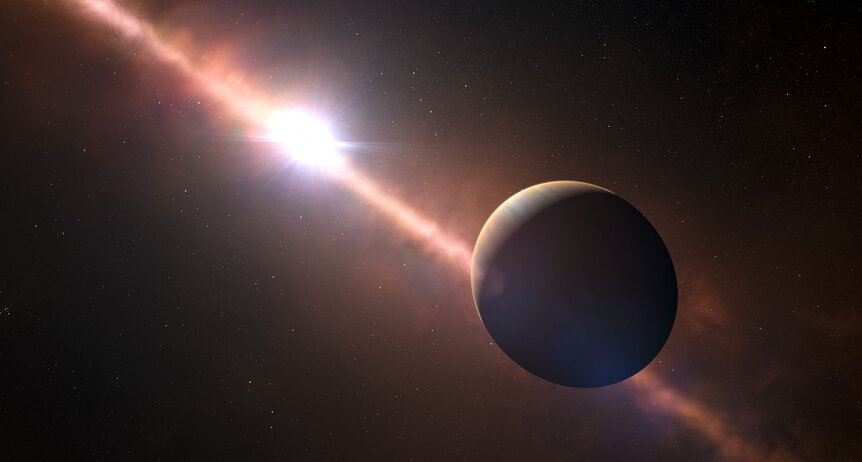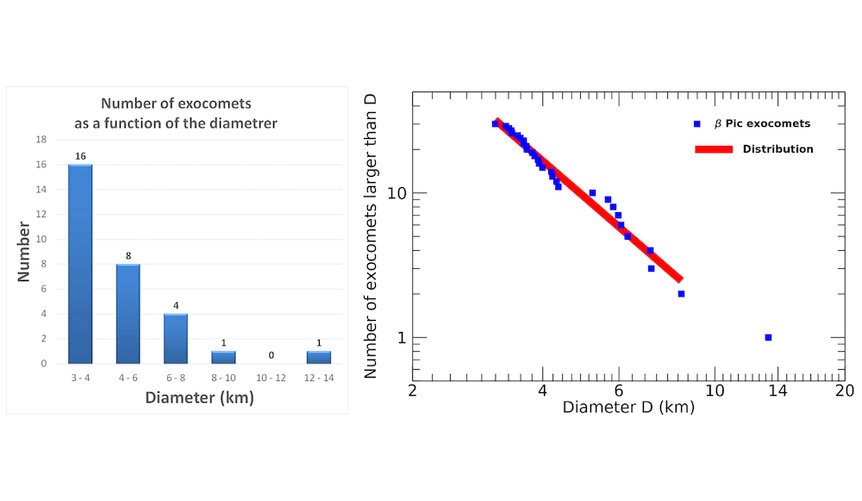Create a free profile to get unlimited access to exclusive videos, sweepstakes, and more!
Exocomets swarm around an alien star… yet seem oddly familiar
Comets around another star look a lot like local ones.

One of my favorite stars in the sky is Beta Pictoris — Beta Pic to its friends. I’ve never seen it myself, but I still like it because it’s one of the very first, decades ago, suspected to have a forming planetary system.
Over the years as technology got better we got better observations of this nearby young star, just 65 light years away and a little over 20 million years old. We saw it has a swirling disk of gas and dust around, the leftover material that formed the star. We see it nearly edge-on, and we now know two big planets are forming in it.
Incredibly, comets have been detected orbiting the star as well — in that case we call them exocomets, just like planets around other stars are called exoplanets. They were actually first detected many years ago, when spectra showed elements like calcium with redshifted light, indicating stuff falling in toward the star. The makeup of the chemicals seen indicated they could come from exocomets.
This was confirmed in 2019 when exocomets were seen to transit the star. OK, first, comets are chunks of rocks, pebbles, and dust held together by ice. When a comet gets near a star the ice turns into gas and the dust and other material is released as well, forming a cloud called the coma around the solid comet nucleus. They get swept back by light pressure and the solar wind, stretched out into long tails.
From our vantage point on Earth, sometimes those exocomets will pass directly in front of the star, blocking its light a little bit — usually by around 0.01%. If you track the brightness of the star over time, the shape of that dip is critical. An exoplanet will cause the light to drop rapidly, then stay constant as the exoplanet crosses the star’s face like a mini-eclipse, and then rise again as the exoplanet leaves the star’s face. The profile of such a graph is symmetric, like a really shallow U-shape.
But an exocomet is different. You get the drop in light, but the trailing tail transits slightly after the coma, so even as the actual exocomet leaves the star’s face the tail still blocks some light. In the end you get a weird fang-shaped graph, which is a pretty clear indicator an exocomet is what transited.
Three of these were seen in data taken by the Transiting Exoplanet Survey Satellite, or TESS, in 2018 and 2019. But now a new set of observations by TESS taken from November 2020 to February 2021 shows transits by 30 different exocomets, and even better, the sizes of the exocomets could be inferred by the transits [link to paper].
Finding the exocomets in the data isn’t easy. Beta Pic is a variable star, changing its brightness in a regular pattern so that has to be accounted for. Plus the comet signals are so faint that any number of noise sources will mess the observations up. One neat thing is that Alpha Pictoris is a star close in the sky to Beta Pic and seen at the same time by TESS. They both are similar kinds of stars and about the same brightness, so Alpha Pic could be used as standard to compare with the Beta Pic data.
Once the data were cleaned up, the 30 exocomet transits showed up, each with its own fang-like shape. And this is where things get cool: The drop in light is proportional to how much dust the exocomet is emitting as it warms and sheds ice. This in turn is proportional to how big the exocomet is; a bigger exocomet has more surface area to blow dust away from. Using some fairly standard assumptions, the astronomers were able to deduce a rough estimate of the sizes of the solid exocomet nuclei, and found they ranged from 3 – 4 km wide up to 12 – 14.
Well, that’s familiar: That’s in line with what we see here in the solar system. You might see much bigger comets but they’re very rare (like the recently discovered monster C/2014 UN271 (Bernardinelli-Bernstein)), so you don’t expect to see one in such a short observation time.
Not only that but the distribution of sizes is familiar, too. In our solar system, comets can break apart or collide, so you expect to see lots of small ones and fewer big ones, and if you plot that distribution — say, number of comets of a given size versus their sizes — you expect to see a line of a certain slope. And that’s just what the astronomers found with the Beta Pic exocomets. It looks like this young alien star makes comets just like our locally sourced Sun does.
That’s an important bit of science. It tells us that the physics of planetary systems around other stars is similar to our own, and in this case very similar. We kinda knew that, but this quantifies it, hangs numbers on it, which is something scientists like to do.
And it also shows something a little deeper. Our solar system may be unique in its individual nature — the chemical abundances, the sizes and distribution of planets, and so on — but totally mundane in general. Other stars are born, they make planets, they make comets. What happens here happens Out There, too.
I find that very comforting. Humans may be a very rare thing, but the conditions that formed us are most certainly not. That doesn’t mean there are lots of other intelligences out there, but it does mean there could be lots of life in general out there.
Every day we learn more about that, too.





























